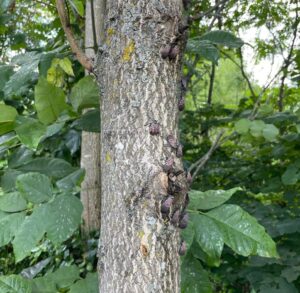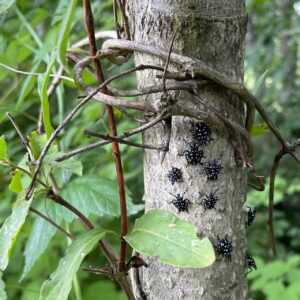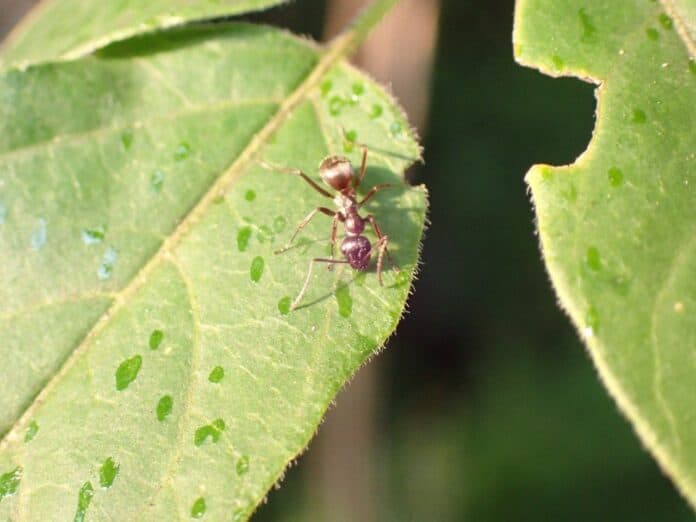Virginia may have a new ally in the fight against one of the most invasive insects threatening trees, crops, and other commodities.
Virginia Tech researchers, led by Assistant Professor Scotty Yang, in the Department of Entomology in the College of Agriculture and Life Sciences, have found a new way to use ants and determine if spotted lanternflies have invaded a new area.
The findings were published in two journal articles in Pest Management Science and Neobiota.
Spotted lanternflies, originally from Asia, have been spreading across parts of the United States since their introduction to the country in 2014, damaging vineyards, ornamental trees, and even backyard gardens. The spotted lanternfly uses its straw-like mouthparts to feed on sap and then leaves behind a sugary substance called honeydew, which not only makes a sticky mess but also contains the insect’s DNA.
Here’s where it gets interesting: Ants love honeydew. They search for it, eat it, bring it back to their nests, and share it with other ants. This connection planted an idea in Yang’s mind: Could these honeydew-collecting ants serve as an early warning system for spotted lanternflies?
Turns out, they can.
Yang, an affiliate with the Virginia Tech Global Change Center‘s Invasive Species Collaborative, found that ants that foraged in areas with spotted lanternflies carried traces of the bugs’ DNA in their bodies — specifically, in the honeydew they’d eaten. By analyzing the ants in a lab, scientists could reliably detect whether spotted lanternflies were present in an area, even if the bugs themselves weren’t spotted directly.
“Ants are nature’s sugar seekers,” Yang said. “If there’s even a tiny drop of honeydew left behind by a spotted lanternfly, ants are likely to find it. They’re constantly on the move, searching for food, and their ability to cover a lot of ground makes them surprisingly effective at picking up traces of the spotted lanternfly.”

To check the ants for lanternfly DNA, the team used a method called environmental DNA testing. Just like people leave behind skin cells or hair, spotted lanternflies leave behind tiny bits of DNA in the honeydew they excrete as waste.
When the researchers collect the ants, they can analyze them for spotted lanternfly DNA using polymerase chain reaction, or PCR, testing that can identify even tiny traces of DNA specific to the lanternfly.
The newly introduced method, called antDNA by Yang and his lab, proved to be both accurate and powerful. Ants that ate just one meal of honeydew from spotted lanternfly still carried the pest’s DNA up to five days later, and because ants roam widely, they detected lanternfly presence up to 100 meters, or 328 feet, away from known infestation spots.
Why early detection matters
The spotted lanternfly is a serious threat to economically important crops and can even be a nuisance in your backyard. It feeds on many types of plants, including grapevine, hops, and hardwood trees. As it feeds, it weakens plants and covers them in honeydew, which can lead to sooty mold growth and further weakening of the plant.
Lanternflies are a complex pest species, and once they invade an area, it may require several methods to get rid of them. Catching them early is preferred. The sooner they’re detected, the easier it is to stop them from spreading.
That’s what makes the antDNA method so exciting, Yang said. Current detection efforts often rely on people physically spotting the insects or their egg masses, which can be challenging until they appear in large numbers, but by then, lanternflies are much harder to combat. With this new approach, teams could simply collect the ants and run a the antDNA test, saving time, money, and the health of the spotted lanternfly host plants.
“One of the biggest advantages of using ants is that they live almost everywhere, such as forests, farms, cities – you name it,” Yang said. “Their constant search for food makes them ideal frontline samplers for spotted lanternfly DNA. This approach isn’t limited by habitat type, and thanks to well-established ant collection methods, we can easily scale it up.”

The implications of Yang’s findings go far beyond just the spotted lanternfly. Any insect that produces honeydew and leaves behind its DNA in doing so could potentially be tracked using this method. That means an earlier, smarter way to protect vulnerable crops, forests, and natural ecosystems.
Yang and his lab are now developing a field-ready antDNA kit that allows the molecular analysis to be done on site, giving results faster, sometimes even within the same day, making it easier to track and respond to new spotted lanternfly invasions in real time.
Original study: https://doi.org/10.1002/ps.8814
Original study: https://doi.org/10.3897/neobiota.98.151420
By James Mason


